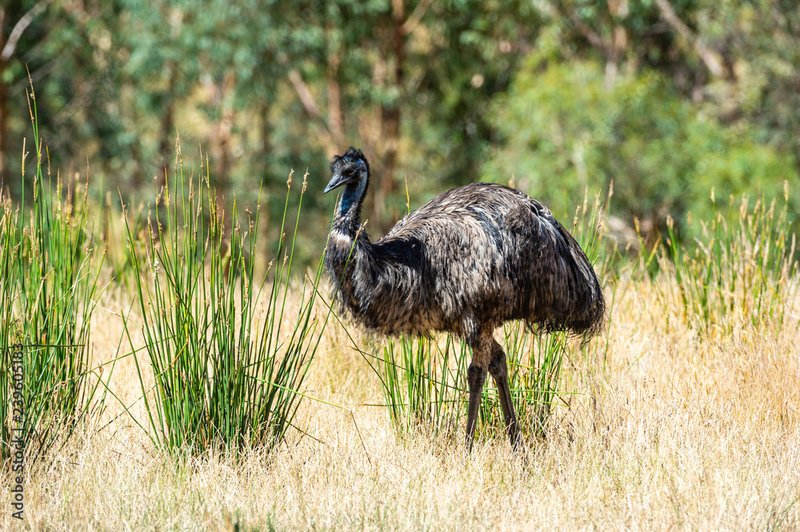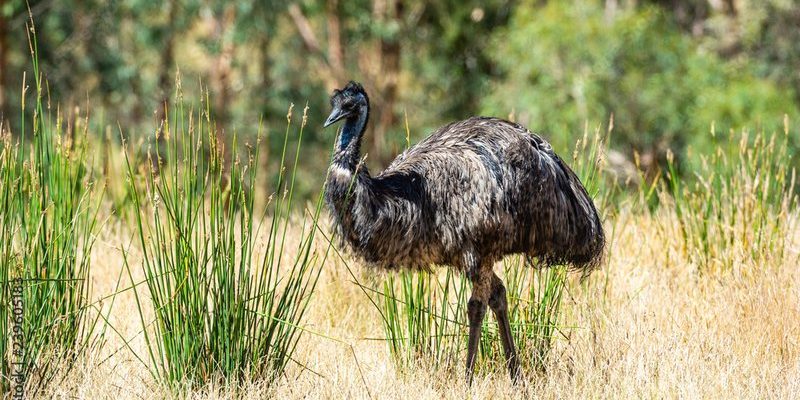
The emu is a remarkable bird, native to Australia, and one of the largest and heaviest birds in the world. Unlike its cousin, the ostrich, the emu has a unique charm, with its long neck, fluffy feathers, and inquisitive nature. Imagine meeting a bird that looks like a feathered dinosaur, with a personality to match. If you’ve ever been curious about these fascinating creatures, you’re in for a treat as we dive into the world of emus.
Emus are flightless, but they certainly don’t let that hold them back. They can run up to speeds of 30 miles per hour, using their powerful legs to navigate through the wild Australian landscape. You might be wondering how they survive in such harsh environments. Emus are surprisingly adaptable, thriving in a variety of habitats, from open forests to grasslands. Let’s explore their lifestyle, diet, and some interesting facts that make them stand out.
Physical Characteristics of the Emu
Emus are truly striking birds, with their tall stature and unique plumage. They can grow up to 6.5 feet tall, sporting a shaggy coat of feathers that can vary in color from brown to gray. These feathers serve multiple purposes: they help with camouflage in the wild and keep the birds warm at night. If you’ve ever tried petting a fluffy animal, you can imagine how delightful their texture might be!
One of the most distinctive features of the emu is its long neck and small head, which gives them a somewhat comical appearance. Their legs are muscular and built for speed, while their large feet have three forward-facing toes, perfect for running across various terrains. You wouldn’t believe how quickly they can move when they feel threatened! Their keen eyesight and excellent hearing help them detect predators, keeping them safe in the wild.
Table: Emu Facts
| Height: | Up to 6.5 feet |
| Weight: | Up to 130 pounds |
| Diet: | Herbivore – seeds, fruits, and flowers |
| Speed: | Up to 30 mph |
| Lifespan: | Up to 20 years |
Habitat and Range of the Emu
You’ll find emus all across Australia, from coastal regions to the heart of the outback. They’re incredibly versatile when it comes to their habitat. Emus prefer open grasslands, woodlands, and even scrublands where they can forage for food and seek shelter. Unlike some other birds that are picky about their homes, emus are quite adaptable, adjusting to the environment around them.
In terms of climate, emus can thrive in hot, arid conditions as well as temperate environments. Their ability to travel long distances in search of food and water is essential for survival, especially during dry spells. Just imagine wandering around the vast outback, spotting these elegant birds gracefully bounding across the landscape. It’s a sight that captures the essence of Australian wildlife!
Diet and Foraging Behavior
Emus are herbivores, meaning their diet consists mainly of plants. They love to munch on seeds, fruits, flowers, and leaves. This diverse diet enables them to thrive in various environments. You might find them foraging in the bushes or running through fields, pecking at whatever looks tasty. Their long necks help them reach vegetation that’s just out of reach for others.
What’s interesting is that emus don’t just eat whatever comes their way; they can be picky eaters! They tend to choose foods that are high in nutrients. This instinctive behavior ensures they get the energy they need for their active lifestyle. Also, emus have a unique adaptation — they can go for days without drinking water! They get most of their hydration from the food they eat, which is a fantastic trait for survival in arid regions.
Reproductive Behavior and Parenting
When it comes to breeding, emus have a fascinating approach. The breeding season typically runs from late summer to early winter. Males and females engage in elaborate courtship displays, which can include dancing, vocalizations, and even gentle nudging. These displays help strengthen their bond and signal readiness to mate.
Once they mate, the female lays a clutch of 5 to 15 dark green eggs. Here’s where it gets intriguing: the male takes on the role of incubator! After the eggs are laid, the female leaves, and the male is responsible for keeping the eggs warm and safe for about 8 weeks. During this time, he can lose a considerable amount of weight, focusing solely on the eggs and rarely eating. After hatching, the chicks are precocial, meaning they can walk and forage almost immediately, but they still rely on their dad for protection.
Conservation Status
Emus are currently not considered endangered, but their populations can be affected by habitat loss and hunting. Thankfully, they are protected in many areas of Australia, allowing their numbers to remain stable. It’s essential to maintain their natural habitats to ensure these magnificent birds continue to thrive in the wild.
Conversely, emus can sometimes cause conflicts with agriculture. Farmers may see them as pests, especially if they raid crops. However, there are ways to manage these situations without harming the birds. Education and awareness about the emu’s role in the ecosystem help promote coexistence between humans and these fascinating animals.
Fun Facts About Emus
Here are some fun tidbits about emus that you might not know:
- Emus can run up to 30 mph, making them one of the fastest running birds!
- They have strong, pointed wings that they use for balance rather than flight.
- Emu feathers are unique — they are soft and fluffy, unlike typical bird feathers.
- An emu’s stride can measure up to 10 feet, allowing them to cover ground quickly.
Emus are a captivating part of Australia’s wildlife, showcasing not only unique physical characteristics but also fascinating behaviors. From their impressive speed to their nurturing parenting tactics, emus embody resilience and adaptability. As we continue to learn about these extraordinary birds, let’s remember the importance of preserving their habitats to ensure they thrive for generations to come. Who wouldn’t want to share the world with these remarkable creatures?
FAQ
What is the lifespan of an emu?
Emus typically live up to 20 years in the wild, although some may live longer in captivity. Their lifespan can be influenced by factors such as diet, habitat, and threats from predators. In protected environments, they often show longer life spans due to better access to food and medical care.
Are emus aggressive toward humans?
Emus are generally not aggressive unless they feel threatened. In most cases, they tend to be curious and passive. However, like any wild animal, it’s best to observe them from a distance and avoid approaching too closely, especially during breeding season or when they have chicks.
Can emus swim?
Yes, emus can swim! They’re not known for being aquatic creatures, but they can paddle through water when needed. Their powerful legs help them navigate in water, making swimming an option if they need to escape predators or cool off during hot weather.
Do emus migrate?
While emus don’t migrate in the traditional sense, they do travel long distances in search of food and water. Their movements are often seasonal, allowing them to adapt to changing environmental conditions, especially during dry periods when food might be scarce in one area.
How fast can an emu run?
Emus can reach speeds of up to 30 miles per hour! Their strong legs and large feet allow them to cover ground quickly, which is essential for escaping predators and finding food. Watching an emu run is quite a sight, as they often appear almost effortless in their movements.
What threats do emus face in the wild?
Emus face several threats, including habitat loss due to agriculture and urban development. They can also be vulnerable to predation by animals such as dingoes and foxes. Additionally, issues like climate change may affect food availability and breeding areas, posing challenges for their long-term survival.
Do emus have any natural predators?
Yes, emus do have natural predators. Young emus are particularly vulnerable to birds of prey, such as eagles, as well as feral dogs and cats. Adult emus, being larger, have fewer predators but still need to be vigilant, particularly when they have chicks to protect.
Can you keep emus as pets?
While it is technically possible to keep emus as pets, they require a lot of space, proper care, and a suitable environment. They thrive in open spaces where they can run and forage. Additionally, in many places, keeping emus may require special permits or licenses, so it’s essential to check local regulations before considering an emu as a pet.
What sound do emus make?
Emus are known for their distinctive grunting and booming sounds. They can produce a range of vocalizations that might remind you of a dinosaur! These sounds are often used for communication during mating displays or to signal alarm when they feel threatened. If you ever hear an emu call, it’s quite memorable!
Do emus lay eggs year-round?
Emus typically do not lay eggs year-round. Their breeding season usually occurs from late summer to early winter. During this time, females will lay a clutch of eggs, after which they will focus on raising the chicks with the help of the males. Outside the breeding season, egg-laying ceases.

